
The Game
The purpose of the 2005 SKILLS Robotics competition was to build a robot that was able to play a
modified game of curling. The robot would curl hocky pucks instead of rocks, and would do so on a four
sided curling rink made of melamine sheeting. Two to four robots would be able to compete simultaniously.
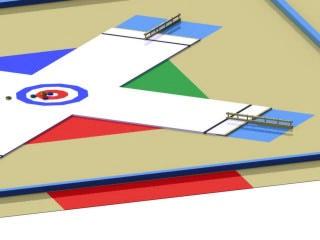
A view of the curling rink can be seen above. The image shows the shooting gates that the robots
must be stationed in, as well as the target area. [1]
Each robot had a designated starting position which was in-between two ends of the X (between shooting positions). Once the competition began, the robot could shoot from any shooting area given, it would not be allowed to shoot from the same position consequitively. As seen in image [1] two robots would be able to shoot from the same end of the X at the same time.
The playing field consisted of a 24 foot square area with a gian X in the center. The legs of the X had a dimension of 4 feet in width, and a length of 7 feet. This means that the distance to the center mark was approximately 9 feet from where the robot was. More Details of the playing field can be seen in the image below.
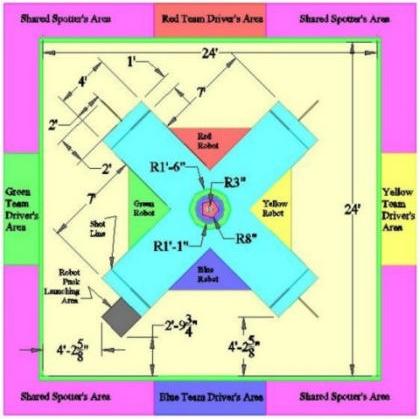
This is the playing field in all it's glory [1]. As you can see there was not very much room for moving
from one shooting area to the other thus having a fast and easy to control robot was essential.
The reason our robot had an advantage and in general did better in the preliminary rounds was because we could out manouver our main opponent. Whenever it appeared they were heading to a given shooting area, we would drive to that area before they could, which would mean that they would have to move toward another. By the time they had begun to move to the other, we had completed shooting and would again move to where they were intending, making it difficult for them to shoot.
The Machine
Bein the first robot I had ever built, and not konwing much about machining, designing, electrical, etc,
we began by brainstorming ideas that would be usefull and appropriate for completing the task without
overkill. Each team member contributed to the overall system. Eventually we decided upon the two wheel
driving base, wheel driven launching wheels, and the complicated puck queue.
Since each team is only allowed a certain number of pucks to shoot, we decided to make a system that would be able to retrieve pucks that had been overshot, or knocked off of the rink. This would allow us to re-use our pucks and have seccond chances. In the end it turned out that the matches were not long enough to be able to utilize this advantage.
The robot's general construction consisted of the following:
- four 7.2V drill motors to drive the machine
- six Ni-Cad batteries to drive the machine
- one Ni-Mh battery to drive the shooting wheels
- two 12V high speed motors to run the shooter
- two car windshield wiper motors, one to run the conveyor belt that fed the shooting motors, and one to
operate the queue advance wedge which removed pucks from the stack and placed them in the conveyor.
(the last motor which was used for puck re-use was removed prior to the competition)
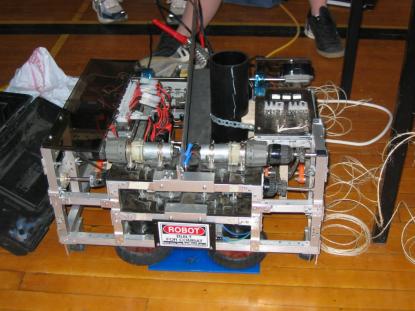
The robot can be seen here, with its multiple parts. The shooting wheels can be seen in the very front.
The two motors on the top are the first two drive motors, one for each side, with the other two mounted
directly underneath them. On the far right and far left are the two electronics enclosures. On the left
just before the electronics enclosure lies the battery nest. The feed conveyor belt sits in the middle
of the robot and can be seen sitting just beside the "smoke stack" or puck queue.
The mechanical makeup of the robot was concieved based on the 2foot by 2foot by 2foot rule. For the structure, we used aluminum tubing and connected them with rivits. Welding was not used because we recycle robots each year. Axels and other drive components were made of stainless steel. The total of this year's robot was approimately 200 dollars mainly because we recycled everything except a special motor speed controller needed for the shooting wheels.
The Build
The building of the robot is an extreamly labour intensive task. Since we only have 6 months to design build and
test the robot, every one of the four members inputs hundreds of hours. Every person is in charge of designing
and building key aspects of the machine.
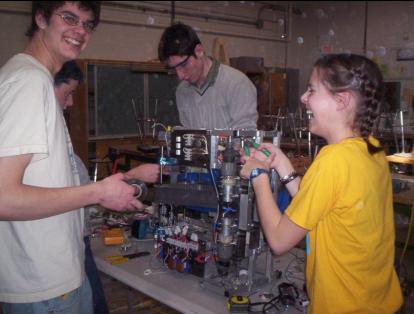
Another one of those "you did not just do that" moments. Since the robot had many interlocking parts that
needed to be assembled in order, we were constantly assembling parts in the wrong order, and needed to take
apart everything and put it all together again.
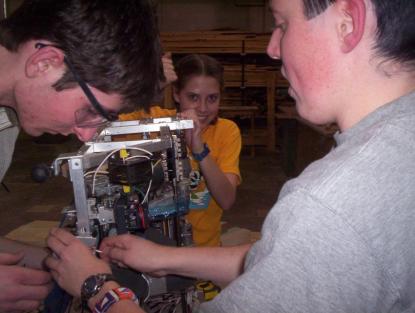
Because of its weight and size, it was often the case that more than one person needed to be involved
in order to put something together. Here we are putting on the castor wheels that stabilize the front
and back of the robot.
The Competiton
The Team
David Mikolajewski -- log
Alissa Van Overbeeke
Brian Houser
Andrea Murphy